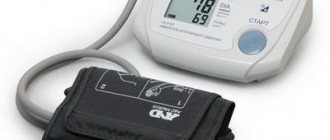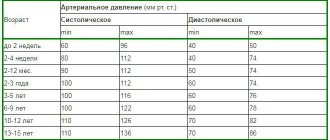Increased blood pressure can otherwise be called arterial hypertension.
Arterial hypertension occurs for a long time without obvious manifestations. However, soon enough it can lead to acute cerebrovascular accidents in the form of TIA (the so-called transient ischemic attack or, in other words, all manifestations of a stroke, but within 24 hours), strokes, as well as to hypertrophy of the walls of the heart and/or enlargement of cavities hearts.
In addition, arterial hypertension is a risk factor for the formation of atherosclerotic plaques in blood vessels and the occurrence of myocardial infarction.
The relationship between blood pressure levels and the risk of cardiovascular disease is linear.
The higher the blood pressure, the greater the likelihood of myocardial infarction, stroke, heart failure and kidney damage.
The prevalence of arterial hypertension (AH) in the Russian Federation is 39.3% among men and 41.1% among women, while blood pressure is properly controlled in only 17.5% of women and 5.7% of men.
Systolic blood pressure increases steadily with age, while diastolic blood pressure rises until age 60 in men and age 70 in women, after which it tends to decrease.
WHAT IS SYSTOLIC DIASTOLIC AND PULSE PRESSURE
Blood pressure is the pressure that blood exerts on the walls of the arteries.
There are:
- systolic pressure
- diastolic pressure
- pulse pressure
Systolic pressure (upper)
This is the maximum pressure in the arterial system developed during contraction of the left ventricle.
It is determined by the volume of blood that the heart pumps out in one contraction, as well as the elasticity of the aorta and large arteries.
Diastolic pressure (lower or heart)
This minimum pressure in the arteries during relaxation of the heart is determined by the amount of tone of the small arterioles.
Pulse pressure
This is the difference between systolic and diastolic blood pressure.
So the reasons for high blood pressure:
What does diastole and systole show?
Diastolic pressure refers to the lower limits of blood pressure, showing the level of blood pressure when the heart muscle is relaxed, the resistance force of blood vessels located on the periphery.
In a normal state, diastole is 80 mmHg. A drop in this figure occurs as a consequence of the reducing effect during the passage of blood flow through the venous, arterial, and capillary lines.
Systolic pressure is the maximum indicator of blood pressure, recorded when the heart contracts and sends blood flow through the vessels. Systole is the upper value, which in a healthy body (without cardiovascular pathologies) is equal to 120 mmHg.
In a person without hidden or obvious diseases, systolic blood pressure changes under the influence of individual triggers:
- strength of heart contractions;
- the level of elasticity of veins, arteries and capillaries, their tone;
- physical activity;
- stress, emotional turmoil.
An increase in systole indicates hidden or obvious pathological processes in the heart and blood vessels. Deviations require a full laboratory diagnostic examination and a competent approach to subsequent therapy.
What does diastolic pressure show?
Lower blood pressure (diastolic) reflects the rate at which blood plasma moves through the arteries during the period of relaxation of the heart muscle (diastole).
Lower pressure is responsible for the condition and functioning of the renal apparatus. For this reason, the diastolic indicator is commonly called renal pressure.
Blood pressure levels change throughout the day under the influence of a number of factors. Therefore, experts have developed a special formula that allows one to determine normal lower pressure and its pathological deviations that require medical intervention (see Volynsky’s formula below).
Diastolic (bottom) pressure is also called renal pressure
Normal limits for lower blood pressure
According to the established classification, the following limits of normal diastolic pressure are distinguished:
- The optimal indicator is up to 80 mm Hg. Art.;
- The permissible norm for diastolic pressure is from 80 to 94 mm Hg. Art.;
- The maximum norm of lower pressure is from 85 to 89 mHg. Art.
If the tonometer readings vary between the values listed above, then this is normal diastolic pressure. Exceeding the maximum permissible level indicates the development of isolated hypertension, which can have different degrees of severity:
- Mild form - diagnosed when lower blood pressure increases to 100 mm Hg. Art.;
- Medium degree - fixed if diastolic blood pressure is increased to 110 mm Hg. Art.;
- Severe form of the disease - an increase in the level of lower blood pressure to 111 mm Hg is manifested. Art. and more.
It should be noted that the lower norm of blood pressure in a person can change under the influence of various reasons. However, if the diastolic reading is persistently elevated, you must consult a doctor and undergo an appropriate medical examination!
Blood pressure standards according to WHO classification
Why does discomfort occur?
The fact is that blood circulates in the human body all the time, even when the person is absolutely not susceptible. While blood enters the ventricles of the heart, the heart muscle spasms, and the blood in the ventricles under pressure comes out into the vessels. The process of filling the vessels occurs so quickly that pressure is created.
As soon as a failure occurs in this mechanism, a person begins to feel a deterioration in his general condition.
We can conclude that blood pressure depends on how intensely the heart contracts. As soon as you see that your blood pressure has deviated from the norm, you should immediately consult a doctor. It is possible that this is due to heart disease. If no heart problems are found, it is worth looking for a problem in other areas of the cardiovascular system.
Blood pressure, which is recorded at the moment the heart muscle pushes blood out of the heart, is called symbolic or upper pressure.
what is the difference between high and low blood pressure
Using systolic pressure, you can accurately determine the heart rate. Normally it is about 110-130.
As a person ages, a person's blood pressure increases. After 50 years, a blood pressure of 140 is considered normal.
But the pressure on the walls of the arteries at the moment of complete relaxation of the heart muscle is called diastolic or lower pressure.
From this indicator one can judge the force with which blood moves through the vessels of the body. If a person is absolutely healthy, then the indicator can be 65-80.
As you noticed, the difference between blood pressure and heart pressure
65 and 80 is significant. It is determined by the individual characteristics of each individual person. If your vessels are in good tone and elastic enough, then the pressure will be about 75-80 units.
What is a person's lower blood pressure responsible for?
The blood ejected during systole quickly passes through the arteries, reaching small capillaries and vessels. The walls of these vessels, contracting, resist the incoming blood flow, and the greater this resistance, the higher the diastolic blood pressure. Therefore, a person’s lower pressure is responsible for the degree of resistance of blood vessels to blood flow. The higher it is, the worse the permeability of the vessels, the greater the resistance they provide to the blood. Conversely, the lower the resistance, the lower the diastolic readings.
Causes of low diastolic pressure
Only a comprehensive examination and consultation with a cardiologist, oncologist, or nephrologist will help you find out the causes of low diastolic pressure, since diseases of the internal organs that cause a decrease in diastolic blood pressure readings may differ. Among them:
- kidney disease (glomerulonephritis, pyelonephritis);
- interruptions in the activity of the heart muscle;
- gastrointestinal ulcer;
- severe allergy attack;
- the presence of infectious foci of inflammation in the body, high temperature;
- oncological diseases;
- autoimmune diseases in the acute stage;
- dehydration due to vomiting and diarrhea caused by poisoning;
- a feeling of severe weakness, which is accompanied by loss of consciousness, from stuffiness in large crowds of people.
Norms
| Age | Male | Female |
| Children under 1 year | 95/67 | 95/64 |
| Children from 10 to 20 years old | 103/70 | 103/71 |
| Young people from 20 to 30 years old | 123/77 | 116/73 |
| Young people from 30 to 40 years old | 126/78 | 120/76 |
| People from 40 to 50 years old | 129/82 | 127/80 |
| People from 50 to 60 | 135/84 | 137/83 |
| People from 60 to 70 years old | 142/86 | 144/86 |
| People from 70 to 80 years old | 145/83 | 159/86 |
| People over 80 years old | 147/83 | 157/84 |
| Old men | 145/77 | 150/78 |
It should be borne in mind that therapy is necessary only if a regular increase in the arterial index is recorded.
If the gap between the upper and lower pressure is higher or lower than normal, then this indicates the presence of pathology in the human body.
- The difference between the systolic and diastolic readings below 40 units indicates possible aortic stenosis or other diseases that arise due to a reduction in stroke volume.
- The difference between the upper and lower indicators above 40 units indicates accelerated aging of all internal organs, especially the heart and brain.
If your blood pressure levels are abnormal, your doctor will be able to find out what this means and what medications are needed. Taking pills on your own, without a doctor’s prescription, is dangerous to your health and also your life. It is impossible to determine whether the lower blood pressure is high or low based on the signs, unlike the upper blood pressure.
How to reduce high diastolic pressure
To normalize the state of the body caused by hypertension, you cannot self-medicate, since there can be many reasons for this pathology. You need to consult with a cardiologist, do examinations, find the cause of hypertension, and only then, together with your doctor, decide how to reduce high diastolic pressure with medication. However, there are simple methods for normalizing blood pressure numbers:
- eating food with a predominance of fruits and vegetables;
- maintaining a daily routine in which sleep takes at least 7-8 hours, an active lifestyle;
- weight normalization;
- leisurely walks in the park for at least an hour and a half a day.
How to lower lower pressure without lowering upper pressure
Isolated diastolic hypertension requires special measures, since it is necessary to decide how to lower the lower pressure without lowering the upper one. Treatment of this pathology is carried out on an inpatient basis, under the medical supervision of specialists who constantly monitor how medications affect the patient so that a decrease in diastolic parameters does not lead to complications in the activity of the heart muscle and a deterioration of the patient’s condition. If the cause of hypertension was an aortic valve defect, complex heart surgery is performed.
Drugs to lower diastolic blood pressure
In each case, medications are prescribed to the patient individually, since the reasons that caused diastolic hypertension can vary dramatically, and self-treatment, randomly choosing medications to lower diastolic blood pressure, is dangerous and strictly prohibited. Doctors prescribe drugs from the following series:
- diuretic drugs;
- drugs that block angiotensin II receptors;
- selective drugs - adrenergic and beta blockers;
- calcium channel antagonists.
Causes of high blood pressure
When measuring pressure, the state of blood flow is assessed - how correctly the blood circulates through the vessels. Hypertension occurs when circulation is impaired and more force from the heart is required to push blood through the vascular bed. This can happen for several reasons:
- Increased blood volume. In this case, the blood puts more pressure on the vessels. Normally, to compensate for excess fluid, the walls of blood vessels stretch, and the pressure normalizes. But, when tissue elasticity is lost, stretching does not occur or is insufficient. Typically, blood volume increases with increased salt intake.
- Narrowing of the lumen of blood vessels. The cross-section of the vessel becomes smaller, making it difficult for the fluid to pass through. In the short term, this condition develops against the background of stress, physical activity, and a sharp drop in temperature. These are reversible reactions. A common cause of constant narrowing of the lumen is atherosclerosis - the deposition of cholesterol plaques.
- Increased blood viscosity. This condition is caused by dehydration, diseases of the immune system, metabolic disorders, obesity, varicose veins, dietary errors, alcohol consumption and other factors. To ensure that thicker blood circulates, high pressure must be created.
A systemic increase in blood pressure indicates chronic pathology. In addition to normalizing blood pressure, it is necessary to diagnose the cause and carry out complex therapy.
Normal values of indicators in men and women
The normal diastolic pressure in an adult largely depends on his gender.
It has been scientifically proven that representatives of the stronger sex have lower (diastolic) blood pressure levels that are always slightly higher than those of the weaker half of humanity.
Scientists explain this fact by the physiological characteristics of the female and male body. Since men have greater muscle mass and are in a different weight category, for optimal supply of nutrients to internal organs and systems they require powerful blood flow, which increases the degree of arterial resistance.
According to the current classification, diastolic pressure in the stronger sex is normally from 76 to 85 mm Hg. Art.
In the fair sex, lower blood pressure levels are influenced by factors such as pregnancy, premenstrual syndrome, menstrual periods, and the onset of menopause.
Hormonal changes that occur in the female body throughout life affect the heart, the size of vascular and arterial lumens, blood flow, circulatory and microcirculation processes.
On average, the norm of lower pressure in women varies from 70 to 84 mm Hg. Art.
According to statistics, men are most susceptible to diastolic hypertension at a young age (up to 50-55 years), and the fair sex, as a rule, encounters this disease upon the onset of menopause.
This is explained by the fact that during menopause, levels of the hormone estrogen in the female body decrease sharply, which increases the likelihood of developing cardiac diseases, hypertension, diastolic hypertension, and atherosclerosis.
The danger of diastolic hypertension
What does high blood pressure mean?
Hypertensive and hypotensive patients should know what elevated lower blood pressure indicates? There may be several variants of pathological deviations:
- both numbers are increased;
- Only systolic indicators are elevated, diastolic indicators are normal;
- high lower pressure, normal upper pressure.
An increase in both numbers on the tonometer indicates the presence of hypertension, which requires urgent treatment. At the same time, the frequency of contractions of the heart muscle increases the load on the circulatory system, but sometimes the situation is the opposite - an increase in diastolic parameters affects the systolic ones. In any case, the mechanism of deterioration in the functioning of the body, depending on the performance of the heart, should be considered comprehensively.
Increased lower pressure with normal upper
Focusing on systolic indicators, people do not know what an increased diastolic level indicates. This is a serious problem that indicates possible kidney disease, since renin promotes vascular contraction and increases muscle tone. This important property of the kidneys determined the second name for diastolic blood pressure - renal. Isolated diastolic hypertension is a pathology when a person has elevated lower pressure with normal upper pressure.
Treatment of low diastolic pressure
Since diastolic hypotension can be caused by a variety of reasons, methods of treating low diastolic pressure consist of: examining the patient, studying his medical history for chronic diseases and allergies to medications, as well as the form of hypotension observed at the moment (it can be acute or chronic in remission ). If the patient has an acute form of hypotension, then the following medications are used:
- Drugs that improve blood supply to the brain and increase pulse blood pressure;
- Medicines that increase vascular tone and help improve blood supply to the body, such as Angiotensinamide. During a hypotensive crisis, it is injected into a vein using a dropper.
- If the patient has demonstrated positive dynamics, and there has been stable improvement in his condition, then doctors prescribe drugs with tonic, immuno- and neurostimulating effects.











